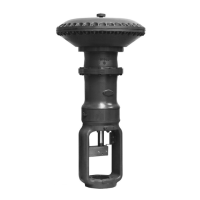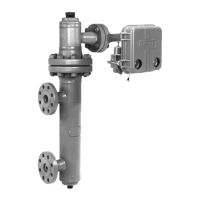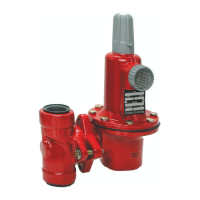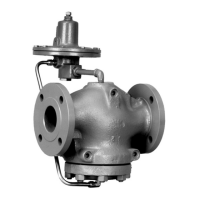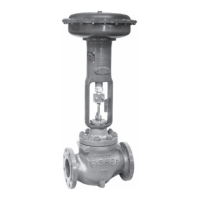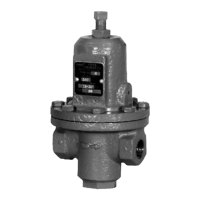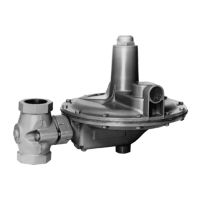Type 99
10
On reassembly of the regulator, it is recommended
that a pipe thread sealant be applied to pressure
connections and ttings as indicated in Figures 7
and 9 and lubricant be applied to sliding and bearing
surfaces as indicated in Figures 7 and 9, and that an
anti-seize compound be applied to adjusting screw
threads and other areas indicated in Figures 9 and 11.
Actuator and Standard P590 Series Filter
This procedure is to be performed if changing the main
spring and spring seat for those of a different range,
or if inspecting, cleaning or replacing any other parts.
Unless otherwise indicated, part key numbers for a
Type 99 regulator with low or high-pressure pilot and
disk or O-ring seat are referenced in Figures 9 through
15, part key numbers unique to the 1000 psig / 69.0 bar
maximum inlet regulator are referenced in Figure 17 and
part key numbers for a Type 61HP (extra high pressure)
pilot are referenced in Figure 18.
1. Access to all internal actuator parts can be gained
without removing the main valve body from the
line. Disconnect the loading tubing from the
upper casing.
CAUTION
If the regulator has an indicator
assembly, perform the following step
carefully to avoid bending the travel
indicator stem (key 103, Figure 6).
Note
The O-rings and gaskets (keys 111 and
108, Figure 6) in the indicator assembly
are static seals and need not be
disturbed, unless they are leaking.
2. Remove the four cap screws (key 58, Figure 9) and
lift off the spring case (key 1). Remove the travel
indicator stem, if any, by unscrewing the indicator
stem adaptor (key 101, Figure 6).
3. Remove the main spring seat (key 2, Figure 9)
and main spring (key 3).
4. Remove the 12 cap screws (key 12, Figure 9) and
hex nuts (key 13), and lift off the upper casing.
5. Remove the diaphragm (key 11, Figure 9) and
diaphragm plate (key 10) by tipping it so that the
lever (key 9) slips out of the pusher post (key 8).
6. Separate the diaphragm (key 11, Figure 9) and
diaphragm plate (key 10) by unscrewing the
diaphragm rod (key 4) from the pusher post (key 8).
Inspect the diaphragm (key 11) and pusher post
gasket (key 7). Either part must be replaced if it is
damaged or no longer pliable.
7. If the unit has a stem seal O-ring (key 64, Figure 7
or 17), this O-ring may be replaced by removing
the retaining ring or cotter pin (key 28, Figure 9)
and disconnecting the lever (key 9) from the valve
carrier (key 26, Figure 9 or 17), removing the union
nut (key 14, Figure 9), disconnecting the pilot supply
tubing (key 24, Figure 9 or 17), and sliding the lower
casing (key 29) away from the valve body (key 17,
Figure 9), with a disk or O-ring seat, the valve carrier
must be pulled out of the lower casing (key 29,
Figure 9 or 17) to gain access to the O-ring. Another
O-ring, held captive by the pressed-in bushing, is
part of the lower casing assembly on a stem seal unit
and normally does not require replacement.
8. If clogging is suspected in the upstream regulator
passages, disconnect the pilot supply tubing
(key 24, Figure 9 or 17), remove the lter
assembly (key 75, Figure 9), and blow through it
to check for lter clogging. If necessary, to clean
or replace lter parts in a standard P590 Series
lter assembly, remove the following as shown
in Figure 16: lter body (key 1), machine screw
(key 4), spring washer (key 6), gasket (key 7),
washers (key 5) and lter element (key 2). Upon
reassembly, one of the two washers (key 5) must
go between the lter element (key 2) and lter
head (key 3) and the other must go between the
lter element (key 2) and gasket (key 7).
9. If the lower casing (key 29, Figure 9) was
removed, install a new body gasket (key 16) and,
with a disk or O-ring seat, slide the valve carrier
(key 26) into the casing (key 29). Then slide
the entire assembly into the valve body (disk
or O-ring seat) and secure with the union nut
(key 14). Secure the lever (key 9) to the valve
carrier (key 26) with the retaining ring or cotter
pin (key 28).
10. Loosely reassemble the diaphragm (key 11,
Figure 9) and diaphragm plate (key 10) so that
the bolt holes (key 11) and loading connection
hole in the diaphragm can be properly aligned
with the corresponding holes in the lower casing
(key 29) when the lever (key 9) is tted properly
into the pusher post assembly (key 8). When this
orientation is made, install the collar (key 6) and
tighten the diaphragm rod (key 4) into the pusher
post (key 8).
11. In order for the regulator to operate properly, the
assembled collar (key 6), diaphragm (key 11),
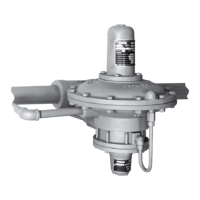
